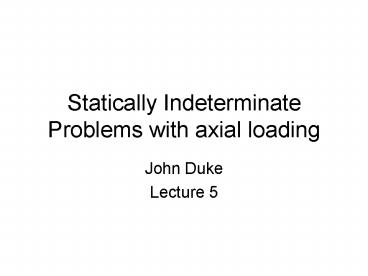Statically Indeterminate Problems with axial loading - PowerPoint PPT Presentation
1 / 15
Title:
Statically Indeterminate Problems with axial loading
Description:
1 equation 1 unknown from STATICS. What do we know about deformation? RIGID END plate d1=d2 ... reactions cannot be determined from statics alone are said to be ... – PowerPoint PPT presentation
Number of Views:475
Avg rating:3.0/5.0
Title: Statically Indeterminate Problems with axial loading
1
Statically Indeterminate Problems with axial
loading
- John Duke
- Lecture 5
2
EX. 2.02
What do we know about deformation?
RIGID END plate? d1d2
1 equation 1 unknown from STATICS
3
Deforms
Statics
Solve for P2 then use it to solve for P1
4
EX. 2.03
1 eqn 2 unknowns from STATICS
5
DEFORMS
6
From STATICS
From DEFORMS
Solve for RA then use it to solve for RB.
7
2.33
See Example 2.02
8
2.39
See Example 2.03
9
2.43
See Example 2.03 with the deformation imposed.
10
2.45
?
dBERAB?
dDCRDC?
Ay Ax
BE BE
BE
DC DC
11
As nut at B is turned force BE develops! dBE
-(1 turn)(deformation due to load) dBE
-(0.1)(PBELBE/AE) LBE 90in-0.1in 90in
12
Static Indeterminacy (using superposition)
- Structures for which internal forces and
reactions cannot be determined from statics alone
are said to be statically indeterminate.
- A structure will be statically indeterminate
whenever it is held by more supports than are
required to maintain its equilibrium.
- Redundant reactions are replaced with unknown
loads which along with the other loads must
produce compatible deformations.
13
Example 2.04
Determine the reactions at A and B for the steel
bar and loading shown, assuming a close fit at
both supports before the loads are applied.
- SOLUTION
- Consider the reaction at B as redundant, release
the bar from that support, and solve for the
displacement at B due to the applied loads.
- Solve for the displacement at B due to the
redundant reaction at B.
- Require that the displacements due to the loads
and due to the redundant reaction be compatible,
i.e., require that their sum be zero.
- Solve for the reaction at A due to applied loads
and the reaction found at B.
14
Example 2.04
15
Example 2.04































